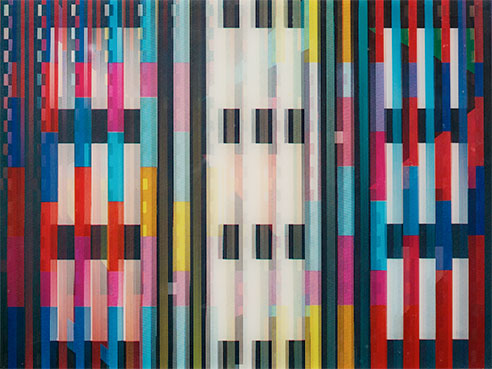 Yaacov Agam (b. 1928). Mazel tov Rainbow; 1993, Agamograph. Private collection of James Altherr and Perry UmphreyMore than 30 small works by world-renowned optical and kinetic art pioneer Yaacov Agam will be on exhibition June 3-Aug. 20 at the University of Alabama at Birmingham.
Yaacov Agam (b. 1928). Mazel tov Rainbow; 1993, Agamograph. Private collection of James Altherr and Perry UmphreyMore than 30 small works by world-renowned optical and kinetic art pioneer Yaacov Agam will be on exhibition June 3-Aug. 20 at the University of Alabama at Birmingham.
“Yaacov Agam: Metamorphic” is presented by the College of Arts and Sciences’ Abroms-Engel Institute for the Visual Arts.
In appreciation for Agam’s long history with the region — Agam created the eye-catching and recently restored “Complex Vision” work visible on the front of the Callahan Eye Hospital to passers-by on University Boulevard for four decades —“Metamorphic” pulls entirely from private collections in and around Birmingham. The exhibition will highlight works spanning multiple decades with a strong emphasis on Agam’s popular Agamograph technique, which utilizes lenticular printing to create different images in a single artwork when viewed from multiple angles.
“Yaacov Agam: Metamorphic” is curated by AEIVA Curator John Fields and supported in part by Judy and Hal Abroms and AEIVA’s generous members.
An opening reception is planned for 6-8 p.m. Friday, June 3, at the AEIVA, 1221 10th Ave. South. The exhibition is free and open to the public. Call 205-975-6436 or visit www.uab.edu/aeiva. AEIVA is open to the public 10 a.m.-6 p.m. Monday-Friday and 12-6 p.m. Saturday. It is closed Sundays and holidays.
Also opening June 3 at AEIVA are “American Sublime: Selections from the Jack and Susan Warner Collection of American Art” and “María Magdalena Campos-Pons: Picturing/Performing the Self,” part of a series exploring Cuban art.
“American Sublime” features 17 works selected from the Warners’ private collection, including masterpieces of 19th and early 20th century American art by Winslow Homer, Jasper Cropsey, Alfred Jacob Miller, Frederick Frieseke, Thomas Cole and Frederic Edwin Church. The exhibition will highlight numerous movements in American Art, including The Hudson River School and the American Impressionist movement, and will foreground the significance of the search for a distinctly “American Sublime.”
Campos-Pons explores the complexity of her heterogeneous Cuban identity in works that include large-format Polaroid photography, as well as video and mixed-media installation. She investigates themes of gender, sexuality and cultural identity. Her multilayered cultural heritage includes ancestry of African, Hispanic and Chinese descent.